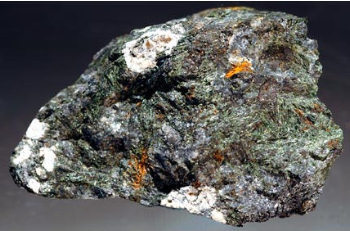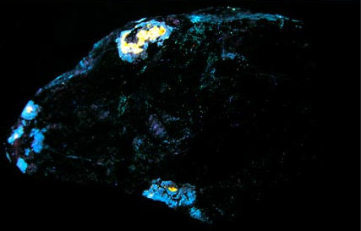Database of luminescent minerals
PARAKELDYSHITE
Chemical formula: Na2ZrSi2O7
Status: IMA-A
Display mineral: NON
Luminescence:
Longwave UV (365nm) colors: |
Orangy yellow , Yellowish White , | ||
Intensity LW:Strong | |||
Shortwave UV (254nm) colors: |
White , Yellowish White , Pale Yellow , Orangy yellow , Pink , Blue , | ||
Intensity SW:Strong | |||
Daylight picture

KELDYSHITE and PARAKELDYSHITE xls, Mt Rasvumchorr, Khibiny massif,
Kola peninsula, MurmanskajaOblast, Russia;
Copyright 2006 S. Schneider,
The World of Fluorescent Minerals,
Used with permission of the author,
Shortwave (254nm) picture

KELDYSHITE and PARAKELDYSHITE xls, Mt Rasvumchorr, Khibiny massif,
Kola peninsula, MurmanskajaOblast, Russia;
Keldyshite fluoresce yellow SW and parakeldyshite white SW,
Copyright 2006 S. Schneider,
The World of Fluorescent Minerals,
Used with permission of the author,
Do you have a photo of this mineral you would like to see in the gallery? Contact us!
Phosphorescence (in the common sense of the term) observable with the naked eye:
No data
Comments:
See KELDYSHITE.
Activator(s) and spectrum:
Activator(s): n[TiO6] cluster,
Peaks in the spectrum (nm):
Very large band with max at 560 nm (Gorobets)
No spectrum yet
Comments on spectrum and activators:
Blue luminescence due to TiO6 ? Cathodoluminescence: dark-blue.
Best localities for fluorescence (*):
- Pegmatite Roadcut at Bratthagen, Lågendalen, Hedrum, Larvik, Vestfold, Norway ;
- Poudrette quarry, Mont Saint-Hilaire, La Vallée-du-Richelieu RCM, Montérégie, Québec, Canada;
- Rasvumchorr Mt, Khibiny Massif, Kola Peninsula, Murmanskaja Oblast, Northern Region, Russia (yellow SW);
- Lovozero, Kola peninsula, Murmanskaja Oblast, Russia ;
(*)The data are not exhaustive and are limited to a few remarkable localities for fluorescence
Bibliographic reference for luminescence:
- The Henkel Glossary of Fluorescent Minerals, Dr. Gerhard Henkel, Published by the FMS, 1989 ,
- Fluorescence: Gems and Minerals Under Ultraviolet Light, Manuel Robbins, 1994, Geoscience Press, ISBN 0-945005-13-X ,
- The World of Fluorescent Minerals, Stuart Schneider, Schiffer Publishing, 2006, ISBN 0-7643-2544-2 ,
- Luminescent Spectra of Minerals, Boris S. Gorobets and Alexandre A. Rogojine, Moscow, 2002 ,
- Mt St Hilaire Website: http://www.saint-hilaire.ca ,
Reference for luminescence on the Internet:
- The Langesundsfjord: history, geology, pegmatites, minerals, Alf Olav Larsen, Bode Verlag Gmbh, 2010 ISBN 978-3-925094-97-2
- MONT-SAINT-HILAIRE, History, Geology, Mineralogy, Laszlo HORVATH, The Canadian Mineralogist, Special Publication 14, 2019
Images:
- Lovozero, Russia: http://www.mindat.org/photo-381339.html
- Bratthagen, Norway: http://www.mindat.org/photo-509460.html
Mineralogical reference on the Internet:
 http://www.mindat.org/show.php?name=Parakeldyshite
http://www.mindat.org/show.php?name=Parakeldyshite
 http://webmineral.com/data/Parakeldyshite.shtml
http://webmineral.com/data/Parakeldyshite.shtml
Internet Search:
 Image search on 'Google Images'
Image search on 'Google Images'
 Search for documents in all languages on Google
Search for documents in all languages on Google
A request providing no result means only that no such reference exists in the database, but it does not mean that what you are looking for does not exist, just not to our knowledge. If you think you have found an error or omission, please let us know via the contact page being sure to cite the source of information.
